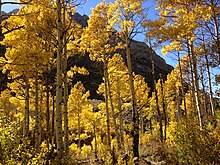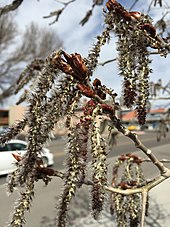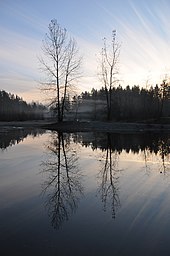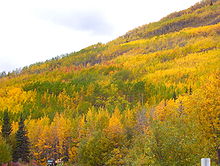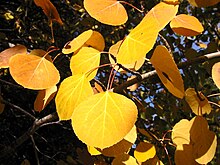
Populus is a genus of 25–30 species of deciduous flowering plants in the family Salicaceae, native to most of the Northern Hemisphere. English names variously applied to different species include poplar, aspen, and cottonwood.
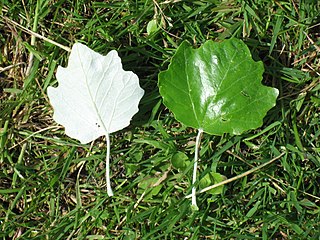
Populus section Populus, of the Populus (poplar) genus, includes the aspen trees and the white poplar Populus alba. The five typical aspens are all native to cold regions with cool summers, in the north of the Northern Hemisphere, extending south at high altitudes in the mountains. The White Poplar, by contrast, is native to warmer regions, with hot, dry summers. These trees are all medium-sized deciduous trees ranging 15–30 metres (49–98 ft) tall.

The term bristlecone pine covers three species of pine tree. All three species are long-lived and highly resilient to harsh weather and bad soils. One of the three species, Pinus longaeva, is among the longest-lived life forms on Earth. The oldest of this species is more than 4,800 years old, making it the oldest known individual of any species. Many scientists are curious as to why this tree is able to live so long. In one study, they discovered that Pinus longaeva has higher levels of telomerase activity, which further slows or prevents the attrition rate of telomeres. This potentially contributes to the extended life of the bristlecone pine.

A clonal colony or genet is a group of genetically identical individuals, such as plants, fungi, or bacteria, that have grown in a given location, all originating vegetatively, not sexually, from a single ancestor. In plants, an individual in such a population is referred to as a ramet. In fungi, "individuals" typically refers to the visible fruiting bodies or mushrooms that develop from a common mycelium which, although spread over a large area, is otherwise hidden in the soil. Clonal colonies are common in many plant species. Although many plants reproduce sexually through the production of seed, reproduction occurs by underground stolons or rhizomes in some plants. Above ground, these plants most often appear to be distinct individuals, but underground they remain interconnected and are all clones of the same plant. However, it is not always easy to recognize a clonal colony especially if it spreads underground and is also sexually reproducing.
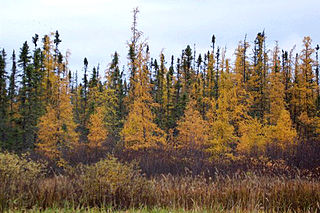
Larix laricina, commonly known as the tamarack, hackmatack, eastern larch, black larch, red larch, or American larch, is a species of larch native to Canada, from eastern Yukon and Inuvik, Northwest Territories east to Newfoundland, and also south into the upper northeastern United States from Minnesota to Cranesville Swamp, West Virginia; there is also an isolated population in central Alaska.
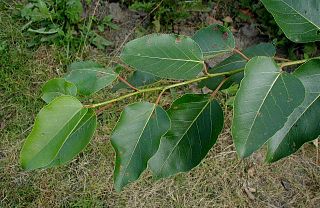
The balsam poplars are a group of about 10 species of poplars, indigenous to North America and eastern Asia, distinguished by the balsam scent of their buds, the whitish undersides of their leaves, and the leaf petiole being round in cross-section. They are large deciduous trees, 30–60 m tall, with leaves with a rounded base, pointed apex, and a whitish waxy coating on the underside of the leaf; this latter distinguishes them from most other poplars. The name is derived from the pleasant balsam smell of the opening buds and leaves in spring, produced by a sticky gum on the buds which also helps protect the buds from insect damage. The balsam poplars are light-demanding trees that require considerable moisture. Balsam poplars are tolerant of very cold conditions, occurring further north than other poplars except for the aspens. The poplars in Southern California are tolerant of 100 plus degree heat. They grow along dry washes and dry riverbed's. The dry washes and dry riverbeds will have flowing water when it rains sufficiently. Their leaves hang down and are at an edge to the sun. This may be another factor why they can take the high heat. Their leaves tremble in the slightest breeze like the quaking aspen
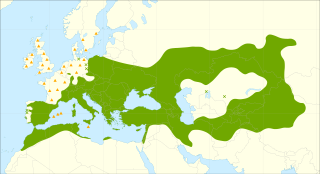
Populus alba, commonly called silver poplar, silverleaf poplar, or white poplar, is a species of poplar, most closely related to the aspens. It is native to a region spanning from the Atlas Mountains of Africa, through most of South and Central Europe, into Central Asia; it has been introduced to many temperate, moist regions worldwide. It grows in moist sites, often by watersides, in regions with hot summers and cold to mild winters.
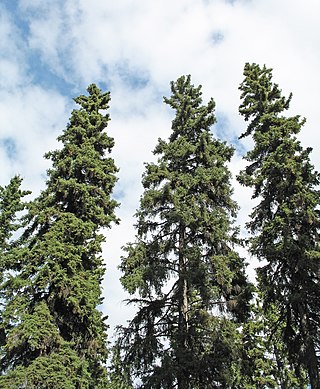
Picea glauca, the white spruce, is a species of spruce native to the northern temperate and boreal forests in North America. Picea glauca is native from central Alaska all through the east, across western and southern/central Canada to the Avalon Peninsula in Newfoundland, and south to Montana, North Dakota, Minnesota, Wisconsin, Michigan, Upstate New York and Vermont, along with the mountainous and immediate coastal portions of New Hampshire and Maine, where temperatures are just barely cool and moist enough to support it. There is also an isolated population in the Black Hills of South Dakota and Wyoming. It is also known as Canadian spruce, skunk spruce, cat spruce, Black Hills spruce, western white spruce, Alberta white spruce, and Porsild spruce.
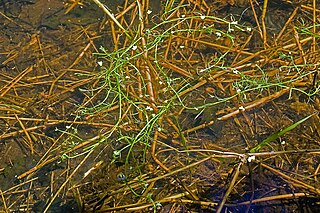
Howellia aquatilis, the water howellia, is a small plant in the family Campanulaceae that was considered a federally threatened species between 1994 and 2021 under the Endangered Species Act of 1973. It is the only species in the monotypic genus Howellia. Thomas Jefferson Howell and Joseph Howell discovered the species in 1878.
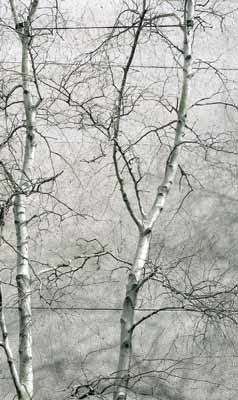
Betula populifolia, known as the gray birch, is a deciduous tree in the family Betulaceae. It is native to eastern North America and is most commonly found in the northeast United States as well as southern Quebec, New Brunswick, and Nova Scotia. The tree is a pioneer species that is commonly found in sites following disturbance, such as fire or logging. Gray birches don't have as much economic value as other birch species but are still commonly used as ornamental trees.
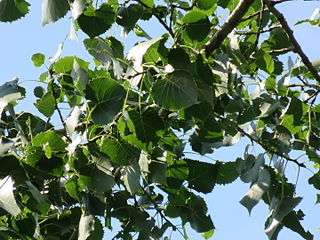
Populus deltoides, the eastern cottonwood or necklace poplar, is a species of cottonwood poplar native to North America, growing throughout the eastern, central, and southwestern United States as well as the southern Canadian prairies, the southernmost part of eastern Canada, and northeastern Mexico.

Populus trichocarpa, the black cottonwood, western balsam-poplar or California poplar, is a deciduous broadleaf tree species native to western North America. It is used for timber, and is notable as a model organism in plant biology.

Populus tremula is a species of poplar native to cool temperate regions of the Old World.
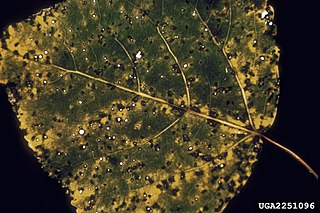
Melampsora medusae is a fungal pathogen, causing a disease of woody plants. The infected trees' leaves turn yellowish-orange. The disease affects mostly conifers, e.g. the Douglas-fir, western larch, tamarack, ponderosa, and lodgepole pine trees, but also some broadleaves, e.g. trembling aspen and poplars. Coniferous hosts are affected in late spring through early August, and trembling aspens and poplars from early summer to late fall. It is one of only two foliage rusts that occur naturally in British Columbia.

Populus grandidentata, commonly called large-tooth aspen, big-tooth aspen, American aspen, Canadian poplar, or white poplar, is a deciduous tree native to eastern North America.

Pando, the world's largest tree, is a quaking aspen tree located in Sevier County, Utah in the Fishlake National Forest. A male clonal organism, Pando has an estimated 47,000 stems (ramets) that appear as individual trees, but are connected by a root system that spans 106 acres. Pando is the largest tree by weight and landmass and, is the largest known aspen clone. Pando was identified as a single living organism because each of its stems possesses identical genetic markers. The massive interconnected root system coordinates energy production, defense and regeneration across its expanse. Pando spans 0.63 miles by 0.43 miles of the southwestern edge of the Fishlake Basin in the Fremont River Ranger District of the Fishlake National Forest and lies 0.43 miles to the west of Fish Lake, the largest natural mountain freshwater lake in Utah. Pando is located at an elevation of 2,700 m (8,900 ft) above sea level.

The Cook Inlet taiga is a taiga and boreal forests ecoregion in Alaska.

Aspen is a common name for certain tree species; some, but not all, are classified by botanists in the section Populus, of the Populus genus.

Entoleuca mammata is a species of fungus in the genus Entoleuca. It is responsible for the plant disease hypoxylon canker in hardwood trees such as quaking aspen and other aspens and poplars, Salix myrsinifolia and other willow species, rowan, Sitka alder, birch, apple, oak, and hop-hornbeam.

Fire adaptations are traits of plants and animals that help them survive wildfire or to use resources created by wildfire. These traits can help plants and animals increase their survival rates during a fire and/or reproduce offspring after a fire. Both plants and animals have multiple strategies for surviving and reproducing after fire. Plants in wildfire-prone ecosystems often survive through adaptations to their local fire regime. Such adaptations include physical protection against heat, increased growth after a fire event, and flammable materials that encourage fire and may eliminate competition.
